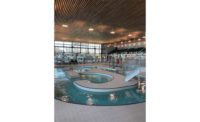McCallie School, located on the slope of Missionary Ridge in the mountainous region of southeastern Tennessee, takes pride in its mission of preparing the next generation of men to have a positive impact on the world.
One of the ways it does this is through a variety of athletics intended to teach boys leadership, teamwork, and a passion for success — key values of McCallie.
With aquatics being an excellent way to experience these, it’s fitting McCallie has one of the best swimming and diving programs in the Southeast U.S. Their team, the Blue Tornado, has won 20 state championships, seven of which were consecutive from 1998 through 2004. The highest-profile student to come out of the aquatics program at McCallie is Sean Ryan, who competed at the 2016 Rio Summer Olympics.
In 2019, the school decided it was time to replace their nearly 30-year-old PoolPak dehumidifier, which was installed in their facility in the 1990s. Like other dehumidifier manufacturers, PoolPak has plenty of experience in replacing old units. There was just one major challenge — when the original unit was installed, the mechanical room was built around it, leaving little space to work around in dismantling it and bringing in a new one.
The facility is not unusual in this sense, as this construction practice has been common in the past and continues with some new facilities built today. It causes challenges in replacing old equipment and sometimes requires expensive temporary building alterations, like knocking out a wall to make room.
As a solution to this common challenge, PoolPak developed Build-on-Site. Facilities can save thousands of dollars in replacement installation costs simply by having the factory come to them to build their new dehumidifier in as little as three days.
With this service, PoolPak sent a factory team to the site to build the replacement with the same care and quality as in the factory itself, after T.S. Raulston Inc. Mechanical Contractors had disassembled and removed the old unit. In fact, Build-on-Site units are delivered within the same timeframe as a unit built in the factory as usual — making this option a great choice for any facility facing a difficult, hard to reach replacement location.
PoolPak approaches every replacement, even of one of its units, as a new job. For this project, Sam Shore, local sales engineer with Trane Chattanooga, coordinated efforts from all parties to generate the new unit selection and the Build-on-Site solution for a successful install.
As with anything in the HVAC industry, understanding of the indoor pool application is constantly evolving. When the original installation occurred in the early ‘90s, much of the science around proper design standards was in its infancy. Therefore, it’s very important to approach any original installation with a modern eye and look for opportunities to bring existing facilities up to today’s standards.
In this case, a site visit by PoolPak National Sales Manager, Richard Oswald, found the original unit was not sufficient for the space to conform to state-of the-art best practices today — something that could be corrected with a new unit.
To properly meet the required dehumidification load of the space, the new unit needed to be approximately twice the size of the original. Additionally, more airflow was needed. The original unit was delivering about two air changes per hour. Modern standards now understand that pools should have a minimum of four per hour and sometimes up to eight.
There was also an opportunity to improve the air delivery pattern in the facility. The area uses below-grade ducting, where air is piped up from the floor rather than down from the ceiling. It was discovered some of the floor diffusers were blocked, interrupting the delivery of fresh air to occupants. By opening these diffusers up, the McCallie School instantly benefitted with a better circulation at no extra cost.
A 40-ton SWHP-SR, a unique PoolPak product ideal for the replacement market due to its economical footprint, was provided to improve the dehumidification and airflow in the space. This like-for-like replacement is phase one of the facility replacement plans.
Due to limited space in the mechanical room, it was not possible to provide a replacement that was sized as required for the facility’s needs. The facility was advised a second unit, installed on the roof, could bring up the hourly air changes and dehumidification capacity to the required level to deliver better air quality and better prevent the condensation that can degrade a facility. The second unit was not immediately procured, but school officials noted the benefits of doing so in the future when in a position to do so.
With a new high-performing dehumidifier and improved air circulation, McCallie’s students will continue excelling in the best possible environment for their personal and athletic development.
Submit your own guest content here!








